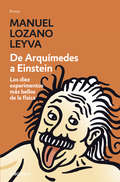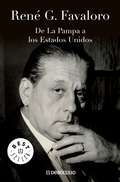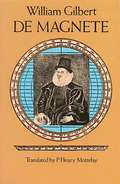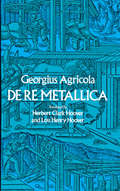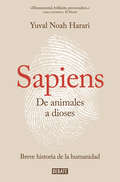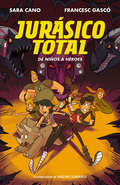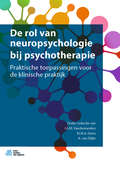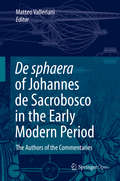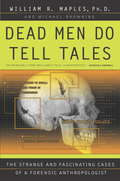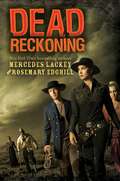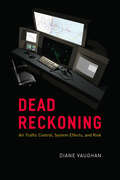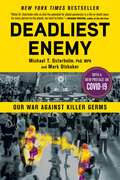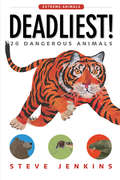- Table View
- List View
De Arquímedes a Einstein
by Manuel Lozano Leyva¿Es bella la física? ¿Existe un hilo conductor que recorre la historia de los experimentos desde Arquímedes hasta Einstein? ¿Podemos encontrar elegancia y creatividad -junto con el sorprendente talento de los científicos- en las observaciones y tentativas físicas que han cambiado la concepción del mundo que vivimos? En el año 2002, se realizó una encuesta entre más de doscientos reputados especialistas mundiales acerca de los experimentos que, con menos medios materiales, han conseguido unir belleza e inteligencia. El resultado de aquel trabajo es este libro del profesor Lozano Leyva, uno de los físicos españoles más brillantes, que recoge, analiza einterpreta cronológicamente las diez experiencias mejor valoradas y más votadas por la comunidad científica internacional. Pensado para el gran público, y gracias a la capacidad de divulgación y síntesis del profesor Lozano Leyva, cualquier lector podrá disfrutar con la desbordante imaginación de los principales científicos (Arquímedes, Eratóstenes, Galileo, Newton, Cavendish, Young, Foucault, Rutherford, Bohr, Schördinger, Heisenberg o Einstein), con sus experimentos (algunos de los cuales pueden reproducirse en cualquier hogar), al tiempo que recorre la historia de la disciplina y sus progresos. Tras la lectura entretenida de este libro la física dejará de ser una materia árida para convertirse en una aventura de la inteligencia.
De Arquímedes a Einstein
by Manuel Lozano LeyvaLos diez experimentos más bellos de la física. Tras la lectura de este ameno libro, la física dejará de ser una materia árida para convertirse en una aventura de la inteligencia. ¿Es bella la física? ¿Existe un hilo conductor que recorre la historia de los experimentos desde Arquímedes hasta Einstein? ¿Podemos encontrar elegancia y creatividad -junto con el sorprendente talento de los científicos- en las observaciones y tentativas físicas que han cambiado la concepción del mundo que vivimos? En el año 2002, se realizó una encuesta entre más de doscientos reputados especialistas mundiales acerca de los experimentos que, con menos medios materiales, han conseguido unir belleza e inteligencia. El resultado de aquel trabajo es este libro del profesor Lozano Leyva, uno de los físicos españoles más brillantes, que recoge, analiza e interpreta cronológicamentelas diez experiencias mejor valoradas y más votadas por la comunidad científica internacional. Pensado para el gran público y gracias a la capacidad de divulgación y síntesis del profesor Lozano Leyva, cualquier lector podrá disfrutar con la desbordante imaginación de los principales científicos (Arquímedes, Eratóstenes, Galileo, Newton, Cavendish, Young, Foucault, Rutherford, Bohr, Schrödinger, Heisenberg o Einstein), con sus experimentos (algunos de los cuales pueden reproducirse en cualquier hogar), al tiempo que recorre la historia de la disciplina y sus progresos. Reseña:«Un derroche de amenidad y capacidad divulgativa.»Emilio Lahera
De La Pampa a los Estados Unidos
by Rene FavaloroEl reconocido cirujano recuerda sus diez años de trabajo en equipo coneminentes personalidades de la medicina durante su estadía en laCleveland Clinic, que derivaron en las técnicas quirúrgicas para elimplante del by-pass de safena. La vida de los hombres oculta razones, decisiones y matices que solo losprotagonistas de esas vidas conocen a fondo. El testimonio del doctorFavaloro permite a los lectores adentrarse en una vida apasionante,tanto por las convicciones que la alientan como por los abundantesepisodios anecdóticos que ayudan a entenderla. La carrera profesionaldel médico argentino que viajó a Estados Unidos para perfeccionarse ylogró convertirse en un cirujano eminente está aquí junto a lasprofundas reflexiones de un hombre cuyos múltiples intereses provocancuriosidad, admiración y respeto.Nada de lo humano fue ajeno para quien eligió el oficio de mejorar lavida. El empeño vocacional a través del paso de los años, laespecialización y sus vínculos con la vida cotidiana, las obligaciones yel exilio, la libertad y el arraigo son temas que «De La Pampa a losEstados Unidos» aborda con deslumbrante lucidez.
De Magnete
by William GilbertMuch of modern science is based upon the theories and discoveries of William Gilbert, the brilliant English physician and physicist who was the first great experimental scientist. Gilbert was the first to use the word "electricity," to recognize mass as distinct from weight, to discover the effect of heat upon magnetic bodies, to differentiate clearly between static electricity and magnetism, and to explain phenomena of terrestrial magnetism in terms of the earth as a giant magnet.In 1600 he published De Magnete in Latin. As lively and entertaining as it was scientifically scrupulous, it summarized everything that had previously been known about electricity and magnetism, founded a new science and earned Gilbert the title of "the father of modern electricity." In it Gilbert explores magnetism and electricity, lodestones, phenomena of magnetism, direction of the earth's magnetic lines of force, variation in the compass, dip, the concept of the earth as a giant magnet, and much else.This Dover edition is a complete, unabridged reprinting of the definitive English translation of De Magnete prepared by Dr. P. Fleury Mottelay. Dr. Mottelay has added a number of footnotes that explain points that might be obscure to today's readers, who will find in this historically important text invaluable insights into the origins of modern science and physics. Translation by P. F. Mottelay. Biographical introduction. 90 illustrations.
De Novo Quantum Cosmology with Artificial Intelligence: Applications of Formal Autoencoders (Chapman & Hall/CRC Artificial Intelligence and Robotics Series)
by Ariel FernándezExperiments attempting to recreate the Big Bang and measurements in deep space point to the tantalizing possibility that our universe may be the relic of something simple, powerful, and highly symmetric. The evidence suggests an entity where matter and energy cannot be told apart and the four fundamental forces are unified into one. Empowered by artificial intelligence, De Novo Quantum Cosmology with Artificial Intelligence seeks to unravel the mystery as it searches for an encompassing physical picture where it all falls into place at the aftermath of creation from a quantum void. From the outset, AI reckons that the problem cannot be tackled without proper contextualization, that is, without dealing with other intimately related problems in particle cosmology including: the nature of dark matter and dark energy, the hierarchy problem of particle masses, the incommensurably weak coupling strength of gravity, the universe topology, the cosmological constant problem, and the vacuum catastrophe. Accordingly, the book addresses the matter in its full conceptual richness. This monograph addresses a broad readership that includes a nonhuman audience involving AI systems. A background in college-level physics and computer science would be essential. Although informal in the approach, the material is presented with scientific rigor, so that readers gain hands-on experience on the subject. The book is geared at graduate students as well as professional physicists, mathematicians, cosmologists, and big data scientists that seek to venture into some of the core problems in particle cosmology empowered by AI. Notably, the book is also geared at nonhuman audiences, since AI systems may incorporate its fundamental operational tenets and take the matter to unfathomable heights.Key Features: Introduces an artificial intelligence system to tackle core problems in particle cosmology Describes a grand unification scheme to explain the common origin of the fundamental forces Identifies the origin of matter as a phase transition from the quantum vacuum.
De Re Metallica: De Re Metallica. Libri Xii. . . (Dover Earth Science)
by Georgius AgricolaOriginally published in 1556, Agricola's De ReM etallica was the first book on mining to be based on field research and observation — what today would be called the "scientific approach." It was therefore the first book to offer detailed technical drawings to illustrate the various specialized techniques of the many branches of mining, and the first to provide a realistic history of mining from antiquity to the mid-sixteenth century. For almost 200 years, Agricola remained the only authoritative work in this area and by modern times it had become one of the most highly respected scientific classics of all time. A book more often referred to in literature on mining and metallurgy than any other, its Latin text prevented it from being as widely used as it might have been. <p><p> In 1912, the book was translated by former President Herbert Clark Hoover and his wife. Printed in a limited edition, the work was quickly bought up by book collectors, historians, and medievalists, who had found that there was much to be learned from its pages. The book contains an unprecedented wealth of material on alluvial mining, alchemy, silver refining, smelting, surveying, timbering, nitric acid making, and hundreds of other phases of the medieval art of metallurgy. The text even covers the legal aspects of mining the use of boundary stones, forfeitures of titles, safety requirements of tunnel building in the 1500s, and so on. <p> But the plates, perhaps more than anything else, have insured Agricola's continued importance. Brilliantly executed drawings, richly detailed, reveal a whole medieval world of machinery, industrial technique, tools, even costume and architecture. All 289 of the original woodcuts are reproduced in this reprint of the 1912 edition, offering students of the period, commercial artists, engineers, metallurgists, and even curious general readers an unforgettable picture of the first age of technology.
De animales a dioses (Sapiens): Una breve historia de la humanidad
by Yuval Noah HarariEl libro de no ficción del AÑO Un best seller internacional con más de un millón de ejemplares vendidos Lúcido e iluminador: la historia de la humanidad en un solo volumen. Este es el fascinante relato de nuestra extraordinaria historia: de simios sin importancia a amos del mundo. ¿Cómo logró nuestra especie imponerse en la lucha por la existencia? ¿Por qué nuestros ancestros recolectores se unieron para crear ciudades y reinos? ¿Cómo llegamos a creer en dioses, en naciones o en los derechos humanos; a confiar en el dinero, en los libros o en las leyes? ¿Cómo acabamos sometidos a la burocracia, a los horarios y al consumismo? ¿Y cómo será el mundo en los milenios venideros? En De animales a dioses, Yuval Noah Harari traza una breve historia de la humanidad, desde los primeros humanos que caminaron sobre la Tierra hasta los radicales y a veces devastadores avances de las tres grandes revoluciones que nuestra especie ha protagonizado: la cognitiva, la agrícola y la científica. A partir de hallazgos de disciplinas tan diversas como la biología, la antropología, la paleontología o la economía, Harari explora cómo las grandes corrientes de la historia han modelado nuestra sociedad, los animales y las plantas que nos rodean e incluso nuestras personalidades. ¿Hemos ganado en felicidad a medida que ha avanzado la historia? ¿Seremos capaces de liberar alguna vez nuestra conducta de la herencia del pasado? ¿Podemos hacer algo para influir en los siglos futuros? Audaz, ambicioso y provocador, este libro cuestiona todo lo que creíamos saber sobre el ser humano: nuestros orígenes, nuestras ideas, nuestras acciones, nuestro poder... y nuestro futuro. - El fuego nos dio poder. - La conversación hizo posible que cooperáramos. - La agricultura alimentó nuestra ambición. - La mitología sostuvo la ley y el orden. - El dinero ofreció algo en lo que confiar. - Las contradicciones crearon la cultura. - La ciencia nos hizo imparables. Reseñas: «Aborda las cuestiones más importantes de la historia y del mundo modernos, y además está escrito con un estilo vívido e inolvidable.»Jared Diamond «Renueva la creencia en la capacidad de decidir de los propios lectores. El éxito más sorprendente y renovador de un libro de no ficción de la última década.»Shmuel Rosner, editor original (Israel)
De dokter en het beeld: Radiologische beeldvorming in de zorg
by Mario Maas Charlotte Nusman Frank Smithuis Roel BenninkRadiologische beelden worden gemaakt bij nagenoeg elke patiënt die in contact komt met de hedendaagse zorg.De beelden zijn overal te bekijken, maar kun je er ook echt iets in zien? Heb je tijdens je studie geleerd te zien wat er (on)zichtbaar afwijkend is? Dat is het domein van de radioloog. De analogie met een rondwandeling door een willekeurig museum ligt voor de hand: je kan veel rondkijken, met een gids of een audiotour in de hand kun je daadwerkelijk meer zien. De dokter en het beeld geeft aan de hand van voorbeelden uit de praktijk inzicht in de rol van radiologische beeldvorming in de zorg. Veelvoorkomende ziektebeelden van de diverse deelgebieden binnen de radiologie worden beschouwd vanuit drie perspectieven: de verwijzer, de radioloog en de patiënt. Deze uniforme doch multidimensionale methodiek geeft de lezer op overzichtelijke wijze inzicht in de rol van beeldvorming in de zorg.
De matasanos a cirujanos: Joseph Lister y la revolución que transformó el truculento mundo de la medicina victoriana
by Lindsey FitzharrisImpresionante e iluminador, De matasanos a cirujanos celebra el triunfo de Joseph Lister, un personaje visionario cuyo propósito de unir ciencia y medicina nos catapultó al mundo moderno. Premio PEN / E. O. Wilson de literatura científica 2018 Tras la pista de un héroe perdido de la ciencia, este libro nos desvela el truculento mundo de la cirugía victoriana conjurando el ambiente de las primeras salas de operaciones y sus admirados «matasanos»: hombres sin miramiento elogiados por su habilidad y fuerza bruta al operar, antes de la invención de la anestesia. En vísperas de una profunda transformación de la medicina, estos pioneros, conscientes de que las secuelas de la cirugía eran más peligrosas que las dolencias mismas, estaban desconcertados por las recurrentes infecciones que se producían tras las intervenciones y que mantenían las tasas de mortalidad obstinadamente altas. Pero, en un momento en que la cirugía no podría haber sido más peligrosa, una figura emergió inesperadamente de las sombras: un joven médico, un cuáquero de talante melancólico llamado Joseph Lister, que resolvería el mortal enigma de la causa de las infecciones y cambiaría el curso de la historia de la medicina. A lo largo de estas páginas, Fitzharris nos retrata el siniestro período comprendido entre 1850 y 1875, presentándonos a un elenco de personajes -algunos de ellos brillantes, otros directamente criminales- que frecuentaron las sucias escuelas de medicina y lúgubres hospitales donde aprendieron su oficio, las macabras morgues donde estudiaron anatomía, y los cementerios ocasionalmente saqueados en búsqueda de cadáveres que diseccionar. Reseñas:«Su biografía de Lister restituye a este olvidado paladín de la observación científica y lo vuelve a situar en el centro de la historia de la medicina [...] Un logro extraordinario.»The Wall Street Journal «Con ojo para los detalles históricos y talento para la prosa, Lindsey Fitzharris nos cuenta uno de los momentos más estelares de la historia de la medicina: el desarrollo de la asepsia quirúrgica. De matasanos a cirujanos es un libro espectacular, horriblemente delicioso y adictivo.»Ed Yong, autor de Yo contengo multitudes «Impactante y estremecedor.»Kirkus Review
De matasanos a cirujanos: Joseph Lister y la revolución que transformó el truculento mundo de la medicina victoriana
by Lindsey FitzharrisImpresionante e iluminador, De matasanos a cirujanos celebra el triunfo de Joseph Lister, un personaje visionario cuyo propósito de unir ciencia y medicina nos catapultó al mundo moderno. Premio PEN / E. O. Wilson de literatura científica 2018 Tras la pista de un héroe perdido de la ciencia, este libro nos desvela el truculento mundo de la cirugía victoriana conjurando el ambiente de las primeras salas de operaciones y sus admirados «matasanos»: hombres sin miramiento elogiados por su habilidad y fuerza bruta al operar, antes de la invención de la anestesia. En vísperas de una profunda transformación de la medicina, estos pioneros, conscientes de que las secuelas de la cirugía eran más peligrosas que las dolencias mismas, estaban desconcertados por las recurrentes infecciones que se producían tras las intervenciones y que mantenían las tasas de mortalidad obstinadamente altas. Pero, en un momento en que la cirugía no podría haber sido más peligrosa, una figura emergió inesperadamente de las sombras: un joven médico, un cuáquero de talante melancólico llamado Joseph Lister, que resolvería el mortal enigma de la causa de las infecciones y cambiaría el curso de la historia de la medicina. A lo largo de estas páginas, Fitzharris nos retrata el siniestro período comprendido entre 1850 y 1875, presentándonos a un elenco de personajes -algunos de ellos brillantes, otros directamente criminales- que frecuentaron las sucias escuelas de medicina y lúgubres hospitales donde aprendieron su oficio, las macabras morgues donde estudiaron anatomía, y los cementerios ocasionalmente saqueados en búsqueda de cadáveres que diseccionar. Reseñas:«Su biografía de Lister restituye a este olvidado paladín de la observación científica y lo vuelve a situar en el centro de la historia de la medicina [...] Un logro extraordinario.»The Wall Street Journal «Con ojo para los detalles históricos y talento para la prosa, Lindsey Fitzharris nos cuenta uno de los momentos más estelares de la historia de la medicina: el desarrollo de la asepsia quirúrgica. De matasanos a cirujanos es un libro espectacular, horriblemente delicioso y adictivo.»Ed Yong, autor de Yo contengo multitudes «Impactante y estremecedor.»Kirkus Review
De niños a héroes (Serie Jurásico Total #Volumen 3)
by Francesc Gascó Sara Cano FernándezLlega la tercera parte de «Jurásico Total». <P><P> ¡Prepárate para vivir mil aventuras en la era de los dinosaurios! <P><P>Carla, Lucas, Dani, Elena y Leo siguen en Pangea, en manos de Kahyla, la guardiana de los ahuluna. <P><P>Ella trata de entrenarlos para que sean también unos héroes dignos, pero... ¡es que ellos no son de ese mundo! Así que lo mejor será que vuelvan a casa y renuncien para siempre a sus amuletos. <P><P>Pero les queda mucho por descubrir en Pangea, y la aventura que vivirán intentando regresar será de las que hacen historia... ¿Lograrán convertirse en héroes y sobrevivir a este viaje?
De niños a héroes (Serie Jurásico Total #Volumen 3)
by Francesc Gascó Sara Cano FernándezLlega la tercera parte de «Jurásico Total». ¡Prepárate para vivir mil aventuras en la era de los dinosaurios! Carla, Lucas, Dani, Elena y Leo siguen en Pangea, en manos de Kahyla, la guardiana de los ahuluna. Ella trata de entrenarlos para que sean también unos héroes dignos, pero... ¡es que ellos no son de ese mundo! Así que lo mejor será que vuelvan a casa y renuncien para siempre a sus amuletos. Pero les queda mucho por descubrir en Pangea, y la aventura que vivirán intentando regresar será de las que hacen historia... ¿Lograrán convertirse en héroes y sobrevivir a este viaje?
De nois a herois (Sèrie Juràssic Total #Volumen 3)
by Francesc Gascó Sara Cano FernándezArriba la tercera part de «Juràssic Total». ¡Prepara't per viure mil aventures a l'era dels dinosaures! <P><P>La Carla, el Lucas, el Dani, l'Elena y el Leo encara són a Pangea, a mans de la Kahyla, la guardiana dels ahuluna. Ella intenta entrenar-los perquè siguin uns herois dignes com ella, però... és que ells no són d'aquest món! <P><P>El millor que poden fer és tornar a casa i renunciar per sempre als seus amulets. Perè els queden moltes coses per descobrir a Pangea, i l'aventura que viuran intentant tornar serà de les que fan història... <P><P>Aconseguiran convertir-se en herois i sobreviure a aquest viatge?
De rol van neuropsychologie bij psychotherapie: Praktische toepassingen voor de klinische praktijk
by J.A.M. Vandermeulen M.M.A. Derix A. Van DijkeDit boek laat zien hoe neuropsychologische problematiek kan interfereren bij psychotherapeutische behandeling. Door hier meer op te focussen, kun je effectiever behandelen en misdiagnostiek voorkomen. Het beschrijft welke problemen je kan tegenkomen bij de behandeling, en welke kennis van neuropsychologische stoornissen nodig is bij aanvang en tijdens de behandeling. Tevens biedt het boek praktische handvatten voor de behandeling in de klinische praktijk. De rol van neuropsychologie in de psychotherapie is opgebouwd uit drie delen. Het algemene gedeelte gaat over de relatie tussen psychotherapie en neurowetenschappen, over kwetsbaarheid en veerkracht en over ontwikkelingsneuropsychologische perspectieven. In het tweede praktijkgericht deel komen de meest voorkomende psychische en psychiatrische problemen aan de orde, zoals depressie, chronische vermoeidheid, posttraumatisch stressstoornissen, ADHD en somatische symptoomstoornissen. Ook leest u over de mogelijke inzet van E-health bij de behandeling van deze patiënten. Deel drie, het tweede praktijkgerichte deel, richt zich op de gevolgen van niet aangeboren hersenletsel (NAH), zoals de identiteit na een NAH, beperkte cognitieve stoornissen, emotionele problemen en gesprekstherapie na hersenletsel. Daarnaast komt ook de mogelijke inzet van E-health bij behandeling van NAH aan de orde. Het boek richt zich op psychologen, psychotherapeuten en psychiaters werkzaam in de ggz. Het boek is eveneens goed bruikbaar binnen de diverse ggz-opleidingen.
De sphaera of Johannes de Sacrobosco in the Early Modern Period: The Authors of the Commentaries
by Matteo VallerianiThis open access book explores commentaries on an influential text of pre-Copernican astronomy in Europe. It features essays that take a close look at key intellectuals and how they engaged with the main ideas of this qualitative introduction to geocentric cosmology. Johannes de Sacrobosco compiled his Tractatus de sphaera during the thirteenth century in the frame of his teaching activities at the then recently founded University of Paris. It soon became a mandatory text all over Europe. As a result, a tradition of commentaries to the text was soon established and flourished until the second half of the 17th century. Here, readers will find an informative overview of these commentaries complete with a rich context. The essays explore the educational and social backgrounds of the writers. They also detail how their careers developed after the publication of their commentaries, the institutions and patrons they were affiliated with, what their agenda was, and whether and how they actually accomplished it. The editor of this collection considers these scientific commentaries as genuine scientific works. The contributors investigate them here not only in reference to the work on which it comments but also, and especially, as independent scientific contributions that are socially, institutionally, and intellectually contextualized around their authors.
De-Extinction: The Science of Bringing Lost Species Back to Life
by Rebecca E. HirschIn the twenty-first century, because of climate change and other human activities, many animal species have become extinct, and many others are at risk of extinction. Once they are gone, we cannot bring them back—or can we? With techniques such as cloning, scientists want to reverse extinction and return lost species to the wild. Some scientists want to create clones of recently extinct animals, while others want to make new hybrid animals. Many people are opposed to de-extinction. Some critics say that the work diverts attention from efforts to save species that are endangered. Others say that de-extinction amounts to scientists "playing God." Explore the pros and cons of de-extinction and the cutting-edge science that makes it possible.
De-Sequencing: Identity Work with Genes (Health, Technology and Society)
by Dana Mahr Martina Von ArxAre you your genes? De-Sequencing: Identity Work with Genes explores this perplexing question, showing how different forms of knowledge must be contextualized to become meaningful. It is generally assumed that the genomic sequence adds up to the identity-forming material life is made of. Yet identity cannot itself adopt the form of a sequence. As the authors in this volume show, the genome must be ‘de-sequenced’ by human language to render it interpretable and meaningful in a social context. The book unpacks this type of ‘sequence-speech’ in engaging detail, adopting a personal, social, cultural, and bio-political approach to examine the transformation of human identity and reflexivity in the era of genetic citizenship.
Dead Center: Behind the Scenes at the World's Largest Medical Examiner's Office
by Shiya Ribowsky Tom ShachtmanThis insider’s account of the NYC medical examiner’s office takes readers from an average day in the autopsy room to the tragic aftermath of 9/11.For fifteen years, Shiya Ribowsky worked as a medicolegal investigator in New York City’s medical examiner’s office—the largest, most sophisticated organization of its kind in the world. Ribowsky led the investigations of more than eight thousand individual deaths, becoming a key figure in some of New York’s most bizarre death cases. He also took charge of the largest forensic investigation ever attempted: identifying the dead in the aftermath of September 11th.Now Ribowsky pulls back the curtain on the New York City’s medical examiner’s office, giving a never-before-seen glimpse into death and the city. From vermin-infested Bowery flophouses to posh Upper East Side apartments of the city’s dead, Ribowsky explores the skeletons that hang in the Big Apple’s closets. Combing through the autopsy room, he also exposes the grim secrets that only a scalpel can reveal, and explains how forensic investigation not only solve crimes—but also saves lives.
Dead Meat: Competing Vitalities, Cultivated Meat Imaginaries and Anthropocene Diets
by Elisabeth AbergelAs we confront the environmental challenges of the Anthropocene, cellular agriculture has emerged as a revolutionary technology promising to reshape global food systems. Dead Meat offers a critical examination of this biotechnological shift, exploring how cultivated meat production reconfigures the relationship between life, death, and food in the context of competing ecological, social, and ethical imperatives. Elisabeth Abergel provides a compelling analysis of cultivated meat through the lens of “competing vitalities”, questioning how these new forms of food production are narrated and imagined in the Anthropocene. She delves into the sociotechnical imaginaries that promise sustainability, animal welfare, and climate resilience, while probing the tensions between these narratives and the political economy of industrial food production. Drawing on interdisciplinary perspectives from the environmental humanities, science and technology studies, political economy, and political ecology, Abergel critiques the idea that cultivated meat is a simple technological fix to the climate crisis. Instead, she exposes how these innovations both challenge and reinforce capitalist logics that dominate agricultural systems. Dead Meat is essential reading for scholars and students in environmental sociology, food politics, science and technology studies, environmental humanities, and political economy, as well as for activists and policymakers interested in sustainable food futures and planetary health.
Dead Men Do Tell Tales: The Strange and Fascinating Cases of a Forensic Anthropologist
by William R. Maples Michael BrowningFrom a skeleton, a skull, a mere fragment of burnt thighbone, Dr. William Maples can deduce the age, gender, and ethnicity of a murder victim, the manner in which the person was dispatched, and, ultimately, the identity of the killer. In Dead Men Do Tell Tales, Dr. Maples revisits his strangest, most interesting, and most horrific investigations, from the baffling cases of conquistador Francisco Pizarro and Vietnam MIAs to the mysterious deaths of President Zachary Taylor and the family of Czar Nicholas II.From the Trade Paperback edition.
Dead Reckoning
by Rosemary Edghill Mercedes LackeyJett is a girl disguised as a boy, living as a gambler in the old West as she searches for her long-lost brother. Honoria Gibbons is a smart, self-sufficient young woman who also happens to be a fabulous inventor. Both young women travel the prairie alone - until they are brought together by a zombie invasion! As Jett and Honoria investigate, they soon learn that these zombies aren't rising from the dead of their own accord ... but who would want an undead army? And why? This gunslinging, hair-raising, zombie western mashup is perfect for fans ofCowboys vs. Aliens and Pride & Prejudice & Zombies.
Dead Reckoning: Air Traffic Control, System Effects, and Risk
by Diane VaughanVaughan unveils the complicated and high-pressure world of air traffic controllers as they navigate technology and political and public climates, and shows how they keep the skies so safe. When two airplanes were flown into the World Trade Center towers on September 11, 2001, Americans watched in uncomprehending shock as first responders struggled to react to the situation on the ground. Congruently, another remarkable and heroic feat was taking place in the air: more than six hundred and fifty air traffic control facilities across the country coordinated their efforts to ground four thousand flights in just two hours—an achievement all the more impressive considering the unprecedented nature of the task. In Dead Reckoning, Diane Vaughan explores the complex work of air traffic controllers, work that is built upon a close relationship between human organizational systems and technology and is remarkably safe given the high level of risk. Vaughan observed the distinct skill sets of air traffic controllers and the ways their workplaces changed to adapt to technological developments and public and political pressures. She chronicles the ways these forces affected their jobs, from their relationships with one another and the layouts of their workspace to their understanding of their job and its place in society. The result is a nuanced and engaging look at an essential role that demands great coordination, collaboration, and focus—a role that technology will likely never be able to replace. Even as the book conveys warnings about complex systems and the liabilities of technological and organizational innovation, it shows the kinds of problem-solving solutions that evolved over time and the importance of people.
Deadenylation: Methods and Protocols (Methods in Molecular Biology #2723)
by Aaron C. Goldstrohm Eugene ValkovThis volume provides new approaches and technologies into roles of poly(A) metabolism in translation, RNA stability, and quality control of gene expression. Written in the highly successful Methods in Molecular Biology series format, chapters include introductions to their respective topics, lists of the necessary materials and reagents, step-by-step, readily reproducible laboratory protocols, and key tips on troubleshooting and avoiding known pitfalls. Authoritative and cutting-edge, Deadenylation: Methods and Protocols aims to pave the way for future investigations of the complex regulatory networks that control mRNA stability and expression.
Deadliest Enemy: Our War Against Killer Germs
by Mark Olshaker Michael OsterholmWe are facing an overwhelming army of deadly, invisible enemies. We need a plan -- before it's too late.Unlike natural disasters, whose destruction is concentrated in a limited area over a period of days, and illnesses, which have devastating effects but are limited to individuals and their families, infectious disease has the terrifying power to disrupt everyday life on a global scale, overwhelming public and private resources and bringing trade and transportation to a grinding halt. In today's world, it's easier than ever to move people, animals, and materials around the planet, but the same advances that make modern infrastructure so efficient have made epidemics and even pandemics nearly inevitable. And as outbreaks of Ebola, MERS, yellow fever, and Zika have demonstrated, we are woefully underprepared to deal with the fallout. So what can -- and must -- we do in order to protect ourselves from mankind's deadliest enemy? <P><P>Drawing on the latest medical science, case studies, policy research, and hard-earned epidemiological lessons, Deadliest Enemy explores the resources and programs we need to develop if we are to keep ourselves safe from infectious disease. The authors show how we could wake up to a reality in which many antibiotics no longer cure, bioterror is a certainty, and the threat of a disastrous influenza pandemic looms ever larger. Only by understanding the challenges we face can we prevent the unthinkable from becoming the inevitable. <P><P>Deadliest Enemy is high scientific drama, a chronicle of medical mystery and discovery, a reality check, and a practical plan of action. <P><P><b>A New York Times Bestseller</b>
Deadliest!: 20 Dangerous Animals (Extreme Animals)
by Steve JenkinsWhat do a cape buffalo, a king cobra, and a puffer fish have in common? They're all deadly! Deadliest! showcases some of the planet’s most threatening creatures. Steve Jenkins's Extreme Animals reader series explores nature's truly superlative animals with the help of illustrations, infographics, facts, and figures while detailing the astounding abilities of critters as small as a frog or as big as a whale. Each installment focuses on truly amazing and unusual animals, making these nonfiction readers accessible, informative, and fascinating.
